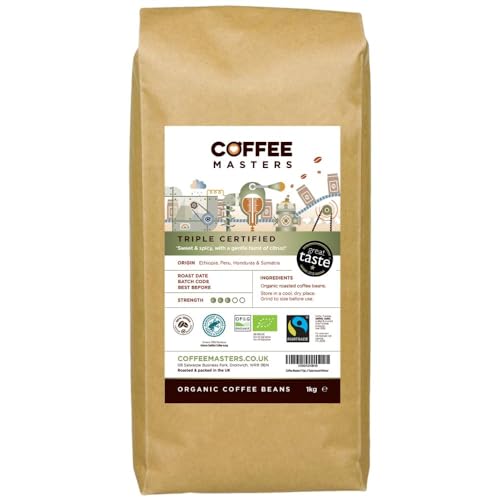The Top Companies Not To Be Keep An Eye On In The Coffee Beans Types Industry

Coffee Bean Types: Arabica, Robusta, Liberica, and Excelsa
If you're a coffee lover you're likely to know that different kinds of beans have distinct flavor profiles. Find out about four of the most well-known varieties: Arabica. Robusta. Liberica. and Excelsa.
Excelsa beans are a kind of Liberica that is only grown in Southeast Asia. They have a fruitier and more tart flavor profile and are often used in blends of coffee to enhance the flavor.
Arabica
Arabica is the most well-known coffee in the world and accounts for 75% of all global coffee bean production. Arabica beans are milder and sweeter than Robusta and come in different flavors. The taste and aroma components of a coffee may vary significantly based on the growing conditions and processing methods used to produce it.
The word "coffee" actually originates from the Arabic word for berry, and coffee beans are fruit seeds that are cultivated inside bright red berries. It is believed that ancient Ethiopian shepherds discovered that their goats were stimulated by eating fruits. The cultivation of coffee grew rapidly all over the world.
Coffee beans can flourish at high altitudes, and thrive in cold temperatures and lots of rain. This is one of the reasons for why Arabica is regarded as the best-tasting type of coffee.
Many specialty coffee shops and roasters focus on ethically sourced arabica beans, focusing on fair wages for farmers and sustainable farming practices. These companies blend arabica beans to create unique specialty coffees that are suitable for many different brewing techniques. Blending allows control over the taste, aroma, body and acidity of coffee. It is often preferred to achieve a consistent and balanced flavor that is appealing to a broad audience.
Robusta
Robusta beans (Coffea canephora) are the second most popular type of coffee bean grown across the globe. They have a higher caffeine content per bean than Arabica and are more resistant to diseases and pests. They also contain higher levels of chlorogenic acids that are antioxidants found naturally. These acids can cause oxidation during the brewing process, and can result in undesirable flavors.
The plant itself is more robust than arabica, able to thrive in less favorable climate conditions and at lower elevations. It can withstand temperatures that are higher and thrives in direct sunlight. It grows faster and produces more coffee per plant than arabica, which makes it a more cost-effective plant to cultivate.
Although it might seem odd it's true that Robusta beans are often blended with arabica to make coffee blends. If you notice names like Uganda or Kenya on the bag of coffee, it's possible that there's also some robusta.
Although some roasters exclusively use arabica beans but the majority do combine the two varieties to cut costs and ensure the quality. To preserve the flavor integrity, you should choose a high quality bean from a reliable source. This can be achieved by buying your beans directly from a farmer.

Liberica
Liberica beans are more or less football-shaped which distinguishes them from other varieties of coffee beans. They have a distinct aroma that is fruity and floral with the smoky notes. They are often blended with other coffee bean varieties to create a more intense, fuller flavor.
Liberica coffee beans are grown in West Africa and Malaysia (Borneo) as and in Southeast Asia. They can be grown at low altitudes and can withstand hot, humid climates. They are also more resistant to disease than Arabica or Robusta.
These attributes make them ideal for home cultivation. It is possible to purchase the seeds on the internet from several sources, but it's recommended to purchase from local producers to guarantee the quality of the beans. The ideal conditions for the cultivation of Liberica coffee are fertile deep volcano soils, with moderately acidic, and enough annual rainfall.
Excelsa is a different type of coffee bean. It was previously classified as a separate species, but has since been reclassified as a Liberica variant. These coffee beans are ovals that grow on 20-30 foot coffee plants at moderate altitudes. bulk coffee beans have a distinct taste that is both tart and fruity, which has made them a preferred choice for blends in house. They are also lighter in the aroma and caffeine compared to Arabica and Robusta yet still have a distinct depth of flavor.
Excelsa
Excelsa coffee beans aren't as common as Arabica and Robusta, despite being the fourth most popular. In fact, they were considered a distinct coffee plant species until 2006 when they were changed to a synonym for Coffea liberica var. dewevrei. They are produced in Southeast Asia today and account for 7 percent of the world's production of coffee. The coffee beans are shaped as teardrops and possess a dark, eerie taste. These beans are often used to give blends additional body and a tangy taste of ripe fruits.
Arabica beans are the most sought-after, and are renowned for having a the most delicious taste. They thrive at higher altitudes and are able to thrive in warm, tropical climates. They also have a touch of acidity. If they are brewed correctly and roast properly they can be flavored like nuts, chocolate or even fruit.
Robusta is the second most sought-after coffee worldwide, and is responsible for around 40% of the coffee consumed around the world. These beans are smaller and rounder however, they contain twice as much caffeine as Arabica. They also have more bitterness than the other two varieties, and tend to have woody and earthy overtones.
After you've learned about the four most commonly used types and their characteristics, it's time to choose your favorite brew. If you prefer smooth and delicate flavors go for an arabica bean or a blend comprised of robusta beans and arabica beans.
